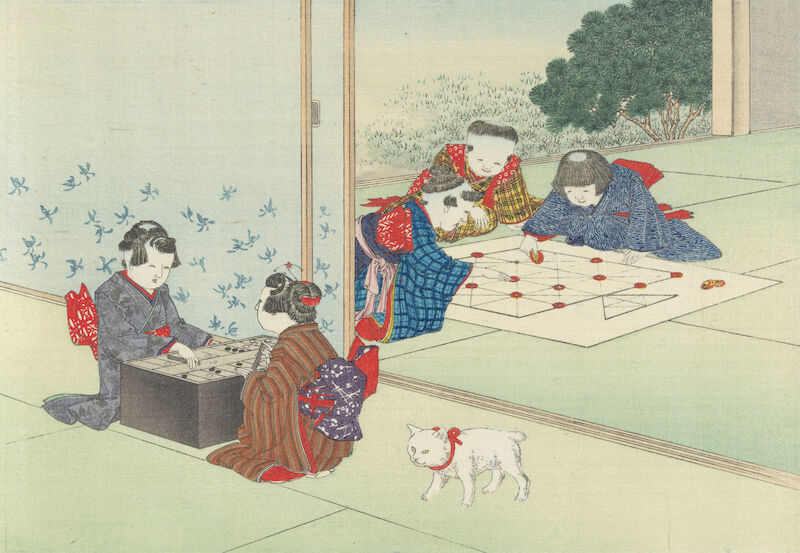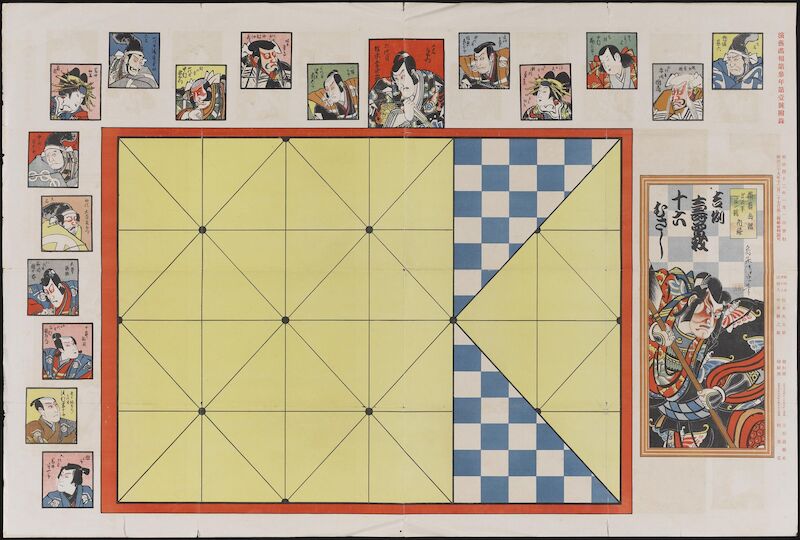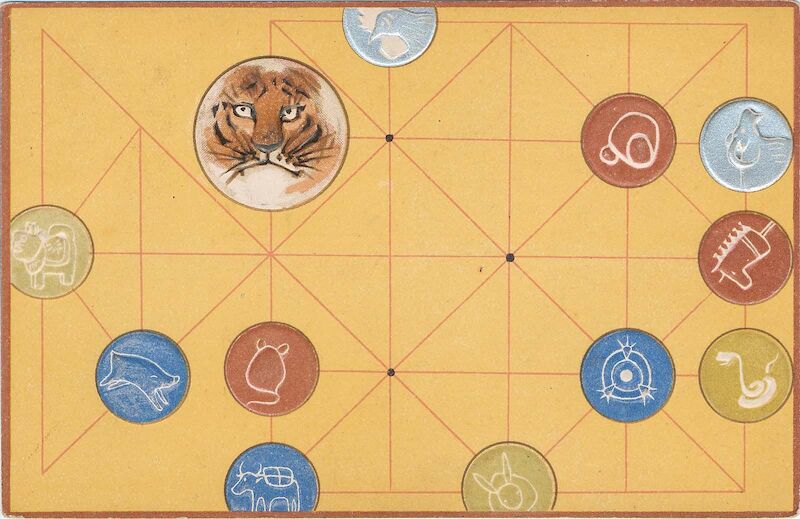十六武蔵 · Sixteen Soldiers
Last updated: .
Sixteen Soldiers (十六武蔵 jūroku musashi) is an asymmetric capturing game from Japan. Similar games (also described here) are played in China and Tibet.

Children playing sixteen soldiers (and sugoroku), Kobayashi Eitaku (小林永濯 1843–90), 1894.
University of Edinburgh, 🅮: 0023305
Play

Initial setup of the board.
© George Pollard, 🅭🅯🄏🄎
One player controls a single larger piece which is placed upon the central intersection of the board. The other player starts with 16 pieces placed on each of the intersections around the border.
The board has 31 intersections on it. On each player’s turn they must move any of their pieces along a line from its intersection to an adjacent empty intersection. If the large single piece moves onto the intersection directly between two other pieces, those pieces are captured and removed from the board.
The goal of the player with the smaller pieces is to surround the single piece so that it cannot move, thus winning the game. The goal of the single piece is to eliminate enough opposing pieces that it cannot be surrounded.

A cut-out-and-play version of the game,
吉例壽曾我十六むさし (‘a festive annual custom, kabuki stars board game’), published by Engei Gahō in 1909.
Princeton University Library, 🅮: ark:/88435/9593tw430
Sixteen Pursue the General

Initial setup of the Chinese board.
© George Pollard, 🅭🅯🄏🄎
In China the game is called “Sixteen pursue the general” (十六趕將軍, Mandarin: Shí liù gǎn jiāng jūn, Cantonese: sap⁶ luk⁶ gon² zoeng¹ gwan¹).A (p. 469)B (p. 874)In older works this is transliterated Shap luk kong tséung kwan or Šĭ liu kan tsiang kün.
The rules of the game are the same as the Japanese version, but it is played on a slightly different board, with a different extension and 29 points.
Water Drowns the Monk

Initial setup of the Sichuan/Tibetan board.
© George Pollard, 🅭🅯🄏🄎
This version, called “Water Drowns the Monk” (水淹和尚, Mandarin: Shuǐ yān héshàng) was reported to be played by shepherds in Sichuan and Tibet (which share a border). The “water” player has 15 pieces and the “monk” player has one. Entering the monk between two water pieces to remove them was termed “carrying water”. The goal of the water player was to drive the monk into the “monastery” extension and pin them there.C (p. 168)
See also
Yasasukari was a possible predecessor of this game.

Japanese postcard for the year 1914 (a year of the tiger), with a game motif.
References
Himly, K. (). ‘Anmerkungen in Beziehung auf das Schach- und andere Brettspiele’ [text in German]. Zeitschrift der Deutschen Morgenländischen Gesellschaft vol. 41 (3): pages 461–484.
Culin, Stewart (). Chess and Playing Cards. Government Printing Office: Washington.
任, 乃强 [Jen Nai-ch’aing] and Dominikus Schröder (). ‘Die Fandse: Ein Beitrag Zur Volkskunde Von Kham’ [text in German]. Folklore Studies vol. 5: pages I–IV & 1–190.